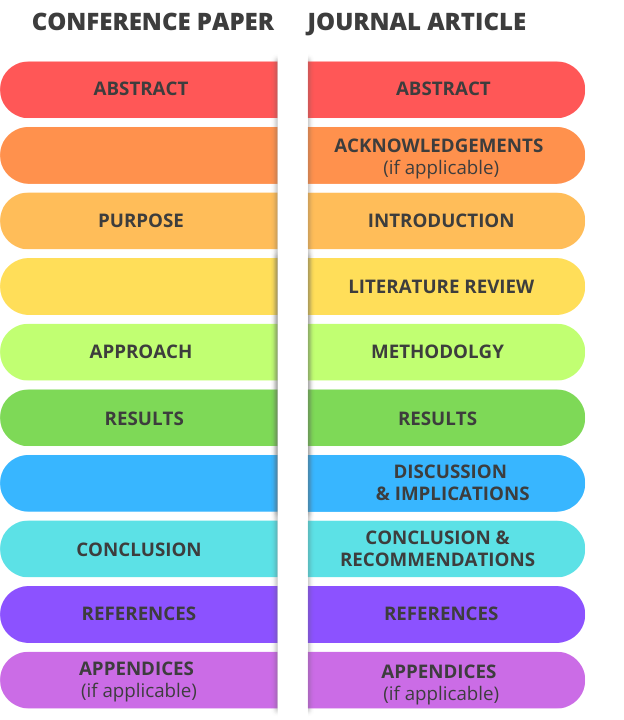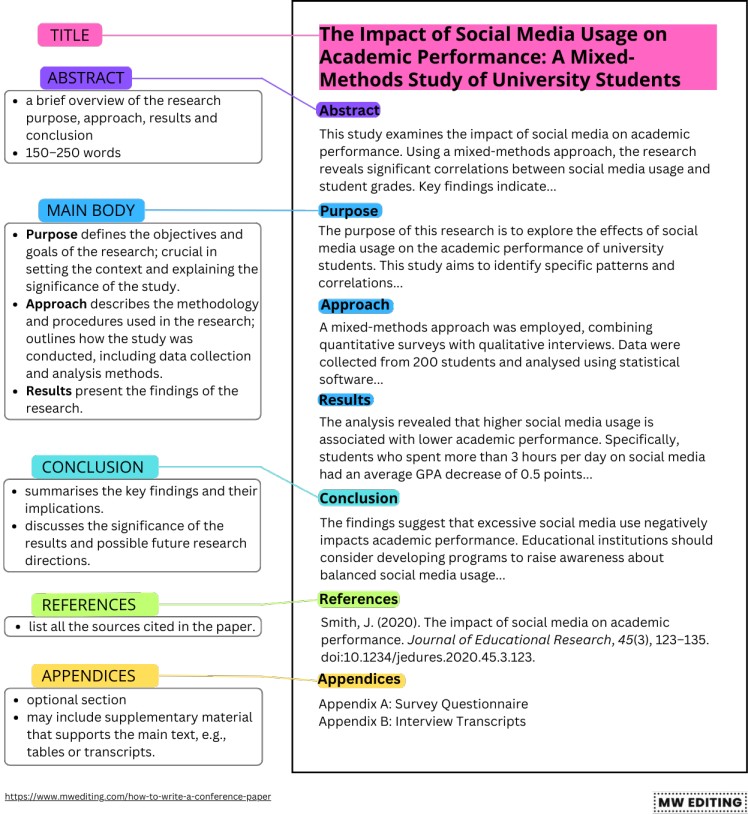A conference paper is a concise scholarly document presented at academic conferences to share new research findings, engage in discussions and receive peer feedback. It differs from a journal article in length, audience and review process. Conference papers are typically shorter and less rigorous and often act as a preliminary step before publishing a full journal article. Structurally, conference papers briefly present the research purpose, approach, results and conclusions. In contrast, journal articles provide a more detailed literature review, methodology and analyses.
- What is a conference paper?
- What is the difference between a conference paper and a journal article?
- What is the structure difference between a conference paper and a journal article?
- Before writing a conference paper
- How to structure a conference paper?
- Useful resources for writing a conference paper
- How to finalise a conference paper?
What is a conference paper?
A conference paper is a scholarly document presented at an academic conference. It summarises research findings for an audience of researchers, professionals and practitioners in an academic field. Its primary purpose is to share new research findings, theories, methodologies or practices and receive feedback through discussions with peers.
Conference papers are generally shorter than journal articles, usually ranging from 4 to 10 pages, depending on the conference requirements. Each conference may have specific formatting guidelines, including templates, citation styles and length limits.
What is the difference between a conference paper and a journal article?
A conference paper and a journal article (also called a research paper or a research article) are both forms of academic writing but have several distinct differences:
- Audience: Conference papers are aimed at conference attendees, while journal articles target the broader academic community.
- Purpose: Conference papers seek immediate feedback and discussion, while journal articles aim to contribute to the academic field more permanently.
- Length: Conference papers are typically shorter (4–10 pages), whereas journal articles are longer (10–30 pages).
- Content: Conference papers summarise the research purpose, methodology, results and conclusions. Journal articles provide a more thorough literature review, detailed methodology, results and discussions.
- Review process: The review for conference papers is generally quicker and less detailed, focusing on relevance and clarity. Journal articles undergo a more rigorous and lengthy review process, often involving peer-review and multiple rounds of revisions.
What is the structure difference between a conference paper and a journal article?
Conference paper structure
- Abstract provides a brief overview of the research purpose, methodology, results and conclusions.
- Purpose states the research objectives and sets the context for the study.
- Approach describes the methodology and procedures used in the research, including data collection and analysis methods.
- Results present the findings of the research supported by data and observations.
- Conclusion summarises the key findings, their implications and significance.
- References lists all the sources cited, following a style guide.
- Appendices (if applicable) include supplementary material, such as data tables or additional analyses.
Journal article structure
- Abstract provides a concise summary of the research, highlighting the main objectives, methods, results and conclusions.
- Acknowledgements (if applicable) allow the authors to acknowledge any funding sources, contributions from colleagues or support received during the research.
- Introduction provides background and context of the study, including literature review and research question or hypothesis.
- Literature review presents the current research within the broader field and identify gaps that the study aims to fill.
- Methodology describes the research design, data collection and analysis methods in detail.
- Results presents the findings of the study, including data and any observed patterns or trends.
- Discussion and implications interpret the results in the context of existing research.
- Conclusion and recommendations summarise the main findings and suggest directions for future research.
- References list of all sources cited in the article, following the specified citation style.
- Appendices (if applicable) include supplementary materials that provide additional context or details.
Key structural differences
- Acknowledgements: Journal articles often include an acknowledgements section, which is usually absent from conference papers.
- Literature review: Journal articles include a detailed literature review section, while conference papers may touch on relevant literature briefly.
- Discussion and implications: Journal articles have a separate, detailed discussion section that interprets the results and explores their implications in depth, whereas conference papers often incorporate discussion within the results or conclusion sections.
- Length and depth: Journal articles are usually longer and more detailed than conference papers.

Before writing a conference paper
Writing a conference paper involves careful preparation and consideration of several factors to ensure your presentation is effective and well-received. Here are key points to keep in mind:
- Read the call for papers (CFP): The CFP should be carefully reviewed to understand the themes, topics, formatting guidelines and deadlines. Aligning the research topic with the conference theme and addressing key questions posed by the organisers is essential.
- Determine the structure and style: The format of the presentation must be decided: visual presentation, reading the paper aloud or combining both. Presentations typically last 15–20 minutes, with an 8–10 page paper fitting within that time limit.
- Understand the session structure: Familiarity with the conference format, professional guidelines and expectations for panels or sessions is important. Communicating with other panellists and coordinating paper submissions can enhance the overall presentation.
- Analyse the audience: Understanding the audience’s knowledge level and interests helps tailor the content to their expectations. Referring to the CFP and conference mission statement aids in addressing broader themes relevant to the field.
- Contextualise the research: The research should be connected to larger trends in the field to increase its relevance and engagement. Highlighting the broader questions and implications of the study enhances its appeal to the audience.
How to structure a conference paper?
The abstract provides a concise summary of the entire paper. It highlights the research purpose, approach, key findings and conclusions, generally within 200–300 words. This section helps readers quickly grasp the main points and decide if they wish to read the full paper.
The research purpose clearly states the objectives and aims of the study. This section outlines the research question or problem being addressed, providing necessary background information to explain the significance of the study. It sets the stage for the rest of the paper by defining what the research aims to achieve.
The research approach describes the methodology used to conduct the research. It includes the research design, data collection methods and analytical techniques, explaining why specific methods were chosen and how they were implemented. This section allows readers to assess the validity and reliability of the findings.
The research results section presents the findings of the study. It includes data, analyses and key results, often illustrated with tables and charts for clarity. This section provides evidence to support the conclusions and gives readers detailed insights into the study’s outcomes.
The conclusion summarises the key findings and their implications. It discusses the significance of the results, their relevance to the field and potential applications. This section may also suggest directions for future research or highlight unanswered questions, providing closure and emphasising the contribution of the research.
The references section lists all sources cited in the paper, following a specific citation style (e.g. APA, MLA). It ensures that all references are accurately cited and formatted, giving credit to original authors and allowing readers to locate the sources.
Last, appendices (if applicable) provide supplementary material that supports the main text. This section may include additional data, detailed calculations or extensive tables that are too lengthy for the main text.

Useful resources for writing a conference paper
Books
- The Craft of Research by Wayne C. Booth, Gregory G. Colomb and Joseph M. Williams covers all aspects of research and writing, from formulating research questions to presenting findings.
- The Elements of Style by William Strunk Jr and E. B. White is a classic reference for writing clearly and concisely, which is crucial for effective conference papers.
- How to Write a Paper by George M. Hall provides comprehensive guidance on writing academic papers, including sections specifically on conference papers.
- Presenting Your Research: Conferences, Symposiums, Poster Presentations and Beyond by Lucinda Becker offers practical advice on presenting research at conferences, including how to structure and deliver your paper effectively.
Reference management software
Writing and editing tools
Plagiarism checkers
Data analysis and visualisation tools
Presentation tools
Other resources
- Introduction to Public Speaking course by the University of Washington on Coursera
- MIT OpenCourseWare: Free lecture notes, exams and videos from MIT courses, including those on writing and communication.
- PODCAST: How to prepare for an excellent conference presentation
- Public Speaking & Presentation Skills 4 Conference Speakers course on Udemy
- Purdue Online Writing Lab (OWL): A comprehensive resource for writing, including style guides and formatting tips
How to finalise a conference paper?
Editing services are crucial in finalising a conference paper, ensuring it is clear, professional and adheres to the necessary standards. Each type of editing service — developmental editing, line editing, copyediting and proofreading — contributes uniquely to refining the paper.
Developmental editing focuses on the content, structure and overall organisation of the paper. It ensures that the arguments are coherent, the structure is logical and the paper effectively communicates its main points.
Line editing then concentrates on the writing style, tone and flow of the paper, ensuring that the text is engaging and the language appropriate for the audience.
Copyediting, on the other hand, addresses grammar, punctuation, spelling and consistency. It ensures that the paper adheres to the specified style guide (e.g. APA, MLA, IEEE) and corrects grammatical, spelling and punctuation errors. Copyediting also ensures consistency in terminology, format and style.
Finally, proofreading provides a final review of the paper to catch any remaining errors, ensuring the text is polished and ready for submission or presentation. It identifies and corrects any overlooked grammar, punctuation and spelling mistakes and ensures the paper is professionally presented.
Key takeaways
In conclusion, writing a conference paper involves understanding its purpose and audience. Conference papers present new research findings concisely to an audience of researchers and practitioners. They often serve as a preliminary step before publishing a journal article. They differ from journal articles in structure, length and review process.
By following conference guidelines, structuring the paper effectively and using appropriate tools and resources, researchers can deliver impactful presentations and engage with the academic community.
If you need help preparing your academic manuscript for publication, contact me for a free sample edit (and remember to use my early bird discount).


